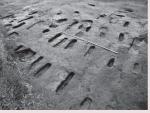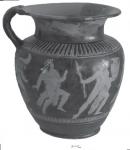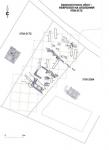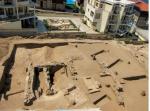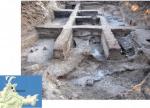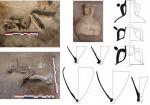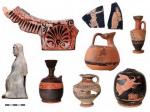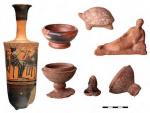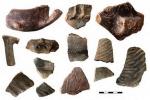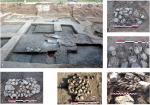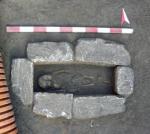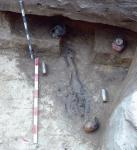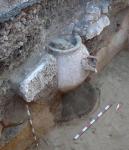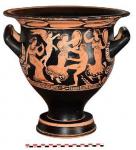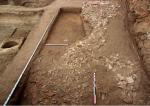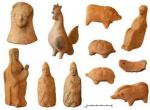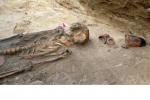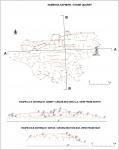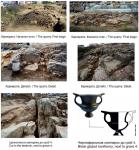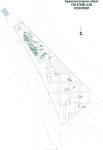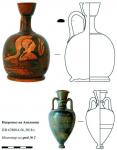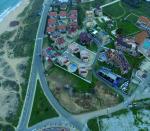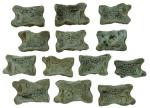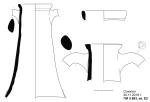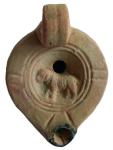Periods
- No period data has been added yet
Season
- EXPLORATIONS IN THE NECROPOLIS OF APOLLONIA (Krastina Panaiotova – kpanayotova@abv.bg, Dimitar Nedev, Antoine Hermary) Ninety-two graves coming from the middle of the 5th to the 3rd centuries BC were discovered. Three of the burials had cremation performed... Read More
- EXPLORATIONS IN THE NECROPOLIS OF APOLLONIA (Krastina Panaiotova – kpanayotova@abv.bg, Dimitar Nedev, Krasimir Nikov, Martin Giuzelev) A water-conduit of the end of the 5th – beginning of the 4th century BC was uncovered, 64 m in length. The necropolis is ... Read More
- EXPLORATIONS IN APOLLONIA (Krastina Panaiotova – kpanayotova@abv.bg, Dimitar Nedev, Martin Giuzelev) The water-conduit of terracotta pipes, 62 cm in length, 16 cm in diameter and connected with lead clamps, was explored at 48.85 m in length. It was used du... Read More
- THE NECROPOLIS OF APOLLONIA (Krastina Panaiotova – kpanayotova@abv.bg, Martin Giuzelev, Dimitar Nedev) The water-conduit of terracotta pipes, which functioned during the end of the 5th and beginning of the 4th centuries BC, was further explored. The water-... Read More
- EXPLORATIONS IN APOLLONIA (Krastina Panaiotova – kpanayotova@abv.bg, Martin Giuzelev) A sector of the water conduit, consisting of 27 terracotta pipes connected with lead clamps, was discovered at 19.10 m length. It functioned during the late 5th and the b... Read More
- ARCHAEOLOGICAL EXPLORATIONS IN APOLLONIA (Krastina Panaiotova – kpanayotova@abv.bg) A quarry was discovered in the western part of the site. Limestone ashlars that were used in the necropolis were cut out there. After the exploitation of the quarry stopped... Read More
- EXPLORATIONS IN APOLLONIA (Krastina Panaiotova – kpanayotova@abv.bg, Margarit Damyanov) Twenty-eight graves cut out into the limestone bedrock were explored. The burial pits were rectangular, 2 – 2.10 m long, 65 – 75 cm wide and down to 1 m deep. There wer... Read More
- ARCHAEOLOGICAL EXPLORATIONS IN APOLLONIA (Krastina Panaiotova – kpanayotova@abv.bg, Margarit Damyanov, Teodora Bogdanova) An area of 0.1 ha situated in the periphery of the necropolis of Apollonia was explored. An inhumation burial was discovered. The dece... Read More
- EXPLORATIONS IN APOLLONIA (Krastina Panaiotova – kpanayotova@abv.bg, Margarit Damyanov, Teodora Bogdanova) Twelve graves of the end of the 5th – middle of the 4th centuries BC were discovered. Nine burial pits were dug out into the bedrock. One burial pit ... Read More
- APOLLONIA (Krastina Panaiotova – kpanayotova@abv.bg, Margarit Damyanov) An area of c. 500 sq. m in the necropolis was explored. A platform of roughly-cut stones was documented and Late Neolithic sherds were found. A large quantity of decorated Thracian she... Read More
- APOLLONIA (Krastina Panaiotova – kpanayotova@abv.bg, Margarit Damyanov) About 50 burials of the 20th century were excavated over an area of c. 450 sq. m. A pile of sherds was explored under them, 2 m by 7 m in size and up to 30 cm thick, containing mainly ... Read More
- APOLLONIA (Yavor Ivanov – iavor.ivanov@gmail.com, Dimitar Nedev) Archaeological structures were discovered during the construction of a drainage channel. Sherds, mostly from amphorae of the 5th – 4th centuries BC, were found. Four burials were explored in ... Read More
- APOLLONIA (Krastina Panaiotova – kpanayotova@abv.bg, Margarit Damyanov) A building constructed in rubble masonry was explored. The finds included sherds, including from early sgraffito pottery of AD 1100 – 1150, the so-called Bulgarian sgraffito pottery of... Read More
- APOLLONIA (Krastina Panaiotova – kpanayotova@abv.bg) Two burial pits of 450 – 400 BC were explored. The first grave was destroyed. Four holes were documented in the corners of the burial pit and they probably accommodated the legs of a wooden funerary klin... Read More
- APOLLONIA (Margarit Damyanov – mmdamyanov@gmail.com, Krastina Panaiotova) A layer with material of the Hellenistic period was documented. Graves of the Late Archaic, Classical and Hellenistic periods were situated under the layer. The pile of fragmentary a... Read More
- APOLLONIA (Yavor Ivanov – iavor.ivanov@gmail.com, Dimitar Nedev) Twenty-four graves of the 5th century BC were explored. The cemetery was situated on two levels: three urns with ashes were discovered from 80 cm to 1.10 m in depth and the rest of the burial... Read More
- APOLLONIA (Teodora Bogdanova – vorbog@gmail.com, Dimitar Nedev) A tomb, 4.80 m by 4.80/4.60 m in size, built of roughly-cut stones was explored. Its entrance was to the east and it was walled with roughly-cut stones. The floor was plastered with lime. Ther... Read More
- APOLLONIA (Teodora Bogdanova – vorbog@yahoo.com, Dimitar Nedev) The explorations were carried out to the east of the Early Hellenistic family tomb discovered in 2016. A stone quarry was discovered and a number of cut outs with regular shape were documented... Read More
- APOLLONIA (Krastina Panaiotova – kpanayotova@abv.bg, Margarit Damyanov) A pit, eight graves (burial pits dug into the bedrock) and a ritual hearth were excavated. The pit measured c. 2.70 m by 2.10 m and contained sherds from amphorae, black-gloss vessels,... Read More
- APOLLONIA (Krastina Panaiotova – kpanayotova@abv.bg, Margarit Damyanov) Occasional finds were discovered on the site: a silver tornese of the 12th century and a Late Mediaeval bronze finger-ring. Terraces into the volcanic bedrock were documented, situated... Read More
- 1900 BC
- 1100 BC
- 800 BC
- 450 BC
- 250 AD
- 800 AD
- 1000 AD
- 1100 AD
- 1250 AD





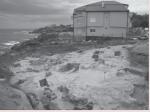
![Download [PDF]](/excavation/skins/fasti/images/results/download_sml.png)
